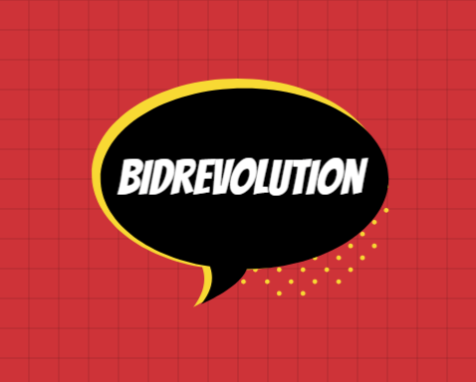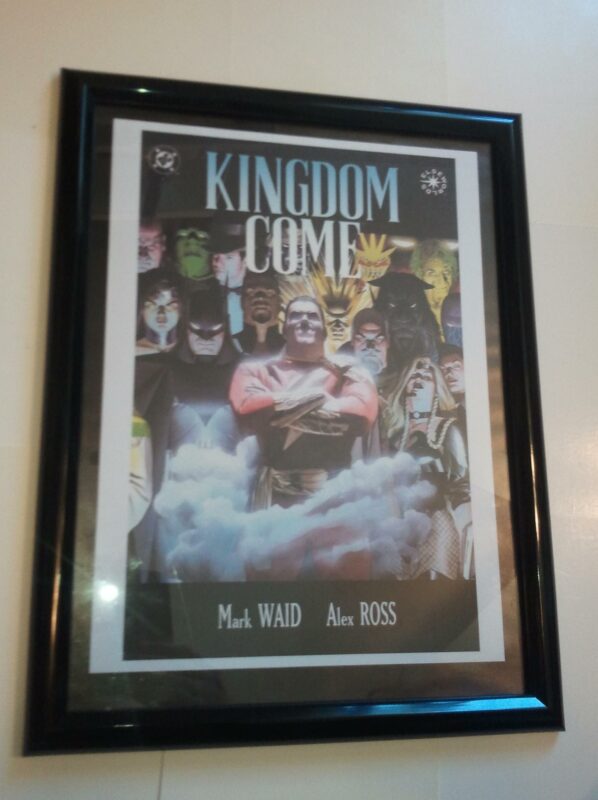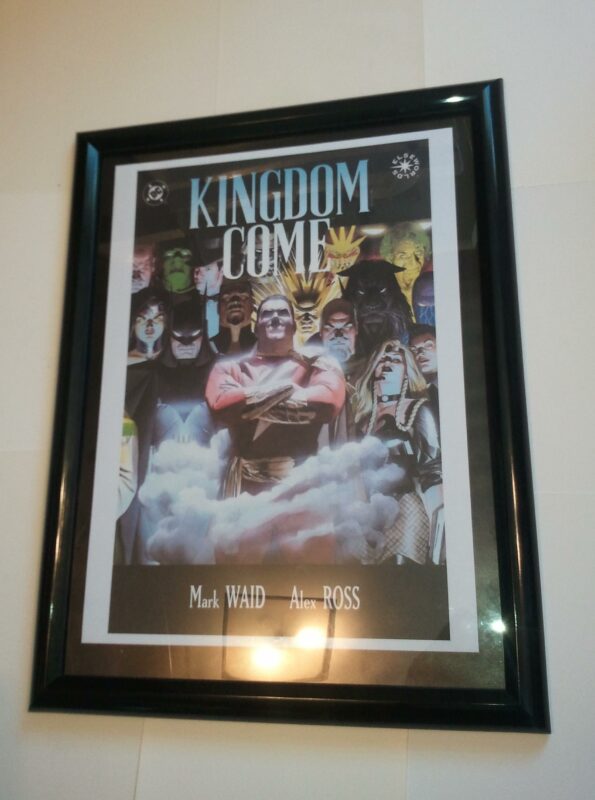Kingdom Come Poster #1 FRAMED Captain Marvel Batman KC #3 (1996) Alex Ross
$74.99
Description
You are purchasing the item pictured, framed. Priority mail, tracking and $50 insurance is included with purchase. Item will be bagged to protect from dust, packed in packing peanuts and boxed. Just open box and hang it on the wall…makes a perfect gift!
Writer Mark Waid and artist Alex Ross’ monumentary miniseries Kingdom Come drew on more than half a century of DC continuity, the Biblical Book of Revelation, and the artist’s own uncanny ability to make the impossibly heroic look photo-realistically alive. Ross’ powerful “group portrait” cover for Kingdom Come # 3 presages the epic battle of the meta-humans that will begin here and reach its Gotterdammerung climax in issue # 4. “As a fan it was exciting when this hit the stands because it offered the first glimse of what Batman would look like in costume for Kingdom Come. Which is to say, awesome. Alex had been coquettishly withholding in the first few issues, depicting Bruce Wayne in a prosthetic exoskeleton, no longer needed a secret identity. That made sense, but it wasn’t nearly as fun to look at. To extend the suspense, Batman doesn’t even appear suited up inside this issue either, that would have to wait until the finale in # 4. But it’s worth holding out for- in my opinion, this is the first design of a “future” Batman that actually improves on the original, mainly because it’s based on the original. Alex took Bob Kane’s very first visual stylings of the character to the next level, turning them into a suit of high-tech armor equipped with a magnificent pair of mechanical wings worthy of da Vinci himself. Oh, and Captain Marvel looks pretty great, too.” – Chip Kidd, legendary graphic designer. Batman’s “Outsiders” from Kingdom Come! Kingdom Come is a four-issue comic book mini-series published in 1996 by DC Comics under their Elseworlds imprint. It was written by Alex Ross and Mark Waid and painted in gouache by Ross, who also developed the concept from an original idea. This Elseworlds story is set in a future that deals with a growing conflict between “traditional” superheroes, such as Superman, Wonder Woman, and the Justice League, and a growing population of largely amoral and dangerously irresponsible new vigilantes, in many cases the offspring of the traditional heroes. Between these two groups is Batman and his assembled team, who attempt to contain the escalating disaster, foil the machinations of Lex Luthor, and prevent a world-ending superhuman war. Batman has formed a group of metahumans, similar to his Outsiders, many of which are second-generation heroes, to combat the Justice League and the Mankind Liberation Front. Playing upon the generational differences between the heroes, five of his heroes are the children of the original Teen Titans, while the Titans have all sided with Superman. At first, Batman and his cadre of heroes seem to enter into an alliance with the MLF as a united front against the Justice League. Now aligned with the Batman, Luthor plans to exacerbate the conflict between the League and the inmates of the Gulag, where the ensuing chaos will afford Luthor an opportunity to seize power. As a master of espionage and deception, the Batman utilizes the Martian Manhunter to discover that an adult Billy Batson is under the villains’ control after retiring from superheroics due to his inability to cope with the world’s increasing brutality and being brainwashed by Luthor, who plays on Batson’s fear that he may be as ‘evil’ as the other metahumans. Batson, who becomes Captain Marvel when he utters the word “Shazam!”, is the one being capable of matching Superman’s power. FRONT ROW: Batman, Captain Marvel, Black Canary III. Since his real identity was made public, the Batman no longer hides behind the carefree appearance of Bruce Wayne; as a result, Wayne Manor was destroyed by Two-Face and Bane. In fact, he is referred to as “The Batman” even in civilian guise and does not bother with the cape and cowl until the final battle. No longer the example of human perfection, he now requires an exoskeleton to move and uses robots and a battle suit to continue his war on crime. He has consequently transformed Gotham City into a police state, his former guise as the cowled vigilante being replaced by an army of large bat-like machines which patrol the streets, controlled by Batman from his sealed-off Batcave. His distrust of both Superman and Luthor leads him to form the Outsiders. He objects to both the League and the MLF’s plans for making a better world, feeling mankind should be able to make its own decisions and mistakes. Captain Marvel “under the control of Lex Luthor, the World’s Mightiest Mortal quickly becomes the world’s mightiest villain.” Black Canary III: “This is the only mother-daughter passing of a super-hero mantle in the series (and the only healthy parent-child relationship shown). Black Canary is a name used for the third time here, with Dinah’s mother being the first. The crossbow-armed child of Oliver and Dinah has additional equipment for warfare and flight. This Black Canary is the first natural blonde to hold the title thanks to her father’s genes.” SECOND ROW: Nightstar, Condor, Lightning, Oliver Queen, Dinah Queen. Nightstar is the daughter of Nightwing (Red Robin) and Starfire. The Revelations supplement says this about her:”Definitely her mother’s daughter, the flying starbolt-firing vixen with the rich, flowing hair and green eyes seems to show more of the superhuman/alien side of her parentage. The half-human, half-Tamaranean child of longtime Titans couple (separated in current storylines) Starfire and Nightwing (Red Robin) is the focal example in Kingdom Come of the generational divide between the classic super-heroes and their children. Nightstar’s estrangement from her father and her mother’s absence in the series could be explained through Starfire’s death, and that that loss somehow led to a rift. That she is a clear visual reminder of her mother (with the exception of her dark, straight hair from dad’s genes) may have been too haunting to Dick Grayson, and therefore he either distanced himself or he may have become overprotective and constrictive of her, fearing for her life. “Throwing in with Batman puts her close to the figurative grandfather she probably never got to know due to the split between him and her father. She may be instrumental in linking up the other original Titans’ offspring. “Visually, she combines her parents’ individual costumed identities with the wing motif of Nightwing and the more violet hue of her starbolt power (Starfire’s was red). “Nightstar’s name and likeness originate in my oldest, longest-running childhood super-heroine designs which, by pure fortune, found a perfect home in the linking of these longtime lovebirds. Condor is the Kingdom Come version of the DC hero Black Condor. The card set describes him as the “current inheritor of the Black Condor mantle.” The Revelations supplement adds this: “The third man to take up the Black Condor mantle is referred to simply as Condor (for obvious reasons). His costume reflects more of the Quality Comics original than his native American predecessor. Artist Tony Akins drew this design.” Oliver Queen: One of Batman’s partners, he has married his long-time love Dinah Lance, Black Canary, and the two have a daughter, Olivia Queen, who also operates as Black Canary. According to the novel, he was killed in the nuclear blast. Dinah Lance Queen: One of Batman’s partners, the former Black Canary now wields a bow like her husband Green Arrow. She was among the fatalities in the Gulag battle, with one panel showing Green Arrow holding her body in his arms after she was accidentally shot in the head by the metahuman Trix. She dies in Queen’s arms during the blast. THIRD ROW: Wildcat III, Nuculoid. Wildcat III is described in the Revelations supplement as “The former boxer turned superhero has been followed by a female version and now a half-animal creature, looking much like the costume come to life. This man-panther is obviously more feral and ferocious.” A man-panther with the spirit of the first Wildcat, Ted Grant. Nuculoid was designed by Alex Ross when he was a kid. An elastic superhero with a nuclear core. His elongated skeleton can be seen amongst the bodies after the Gulag bombing. LAST ROW: John Jones, Mysteryman, Zatara II, Samurai, Dragon, Bat-Knight, Creeper. John Jones is described in the card set as “former Martian Manhunter, now has psychological problems.” Mysteryman is described in the card set as “one of Batman’s fellow crimefighters.” Chris Gumprich and Hunter Rose point out that there was a Silver Age Batman story (Detective Comics #245, “The Dynamic Trio”) in which Batman teamed up with a green-suited hero called “Mysteryman.” The hood of that “Mysteryman” (who was later revealed to be Commissioner Gordon) is quite similar to the one seen here. The Revelations supplement says this about Zatara II: “The son of the late Zatanna and grandson of the original Zatara is a youthful Harry Houdini-like successor to the magician super-hero lineage.” The son of the late Zatanna and John Constantine, and grandson of Giovanni Zatara. Besides being a magician, he’s inherited his father’s ability to see the dead. According to the novel, he was so horrified by the nuclear blast that he was unable to use his magic to escape. Samurai is described in the card set as “champion of Japan, from the Batmen of many nations.” The Revelations supplement says this about him: “The champion of Japan is more along the lines of the original Batman of many nations, his basic costume taken from classical Japanese armor. The samurai were a hereditary warrior class in feudal Japan.” Dragon is described in the card set as “champion of China, from the Batmen of many nations.” The Revelations supplement adds this: “The champion of China is styled most closely like Batman, using a fearsome creature, well associated with Chinese culture and history, for his costume.” Bat-Knights: Batman’s robotic guardians of Gotham City, each of which resembles a cross between a Batmobile and a Transformer. At least two of them were sent into the Gulag battle until they were destroyed by the bomb. At the end of the graphic novel, they are painted white and used as air filtration units when Wayne Manor is turned into a hospital/hospice. The Creeper is the Kingdom Come version of the DC hero, and is described in the card set as an “aging, wretched screwball superhero.” Though he has aged, he is still the insane screwball he was when he was young. In the novelization, he switches sides several times during the Gulag battle, and is killed in the nuclear blast. As was pointed out by Waid/Ross, while the original Teen Titans–Flash III (most likely Wally, formerly Flash IV), Red Arrow (formerly Speedy), Red Robin (formerly Robin, formerly Nightwing) Aquaman II (formerly Aqualad), and Donna Troy (formerly Wonder Girl) are siding with Superman, their children–Flash IV, Red Hood, Nightstar, Tula, and Darkstar–are aligned with The Batman. All of the characters on the cover are lit from below, with the exception of Captain Marvel. Symbolic, of intimate connections with higher powers, perhaps? Nelson Alexander “Alex” Ross is an American comic book writer/artist known primarily for his painted interiors, covers, and design work. He first became known with the 1994 miniseries Marvels, on which he collaborated with writer Kurt Busiek for Marvel Comics. He has since done a variety of projects for both Marvel and DC Comics, such as the 1996 miniseries Kingdom Come, which Ross also co-wrote. Since then he has also done covers and character designs for Busiek’s series Astro City, and various projects for Dynamite Entertainment. His feature film work includes concept and narrative art for Spider-Man and Spider-Man 2, and DVD packaging art for the M. Night Shyamalan film, Unbreakable. He has also done covers for TV Guide, promotional artwork for the Academy Awards, posters and packaging design for video games, and his renditions of superheroes have been merchandised as action figures. Ross’ style has been said to exhibit “a Norman-Rockwell-meets-George-Pérez vibe”, and has been praised for its realistic, human depictions of classic comic book characters. His rendering style, his attention to detail, and the perceived tendency of his characters to be depicted staring off into the distance in cover images has been satirized in Mad magazine. Because of the time it takes Ross to produce his art, he primarily serves as a plotter and/or cover artist. Comics Buyer’s Guide Senior Editor Maggie Thompson, commenting on that publication’s retirement of the Favorite Painter award from their CBG Fan Awards due to Ross’ domination of that category, stated in 2010, “Ross may simply be the field’s Favorite Painter, period. That’s despite the fact that many outstanding painters are at work in today’s comic books.” In 1996, Ross worked with writer Mark Waid on the DC Comics limited series Kingdom Come, which presents a possible future for the DC Universe, in which Superman and several other classic superheroes return from retirement to tame a generation of brutal anti-heroes. The work featured Ross’ redesigned versions of many DC characters, as well as a new generation of characters. Ross also co-created the original character Magog, patterning his appearance and costume from two characters created by Rob Liefeld, Cable and Shatterstar.
>PAN>Frame is shrinkwrapped until time of purchase. Ships boxed with packing peanuts.
THE PERFECT GIFT!
Related products
-
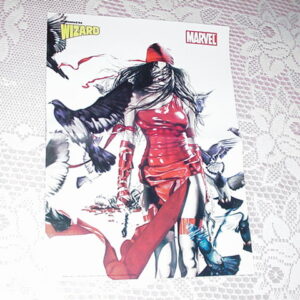
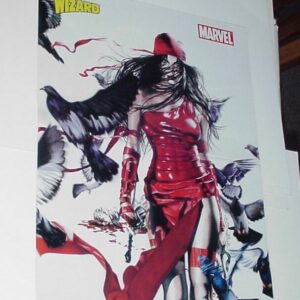
Elektra Poster # 2 by Rodolfo Migliari Daredevil Thunderbolts
$29.99 Add to cart -

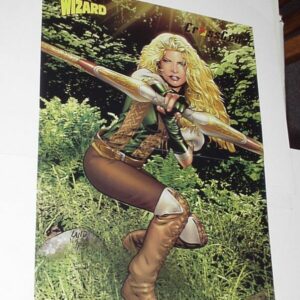
CrossGen Poster #18 Arwyn Greg Land Sojourn Bow of Ayden
$29.99 Add to cart -
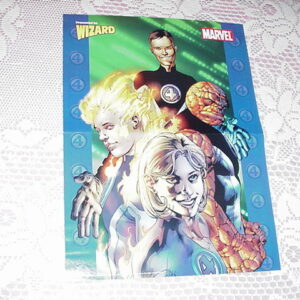

Ultimate Fantastic Four Poster # 1 Bryan Hitch Reed Johnny Sue Ben
$39.99 Add to cart -

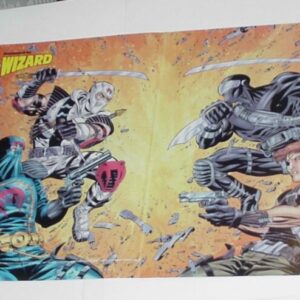
G.I. Joe Poster # 3 Cobra Commander Storm Shadow vs Snake Eyes and Billy by Mike Zeck
$34.99 Add to cart
